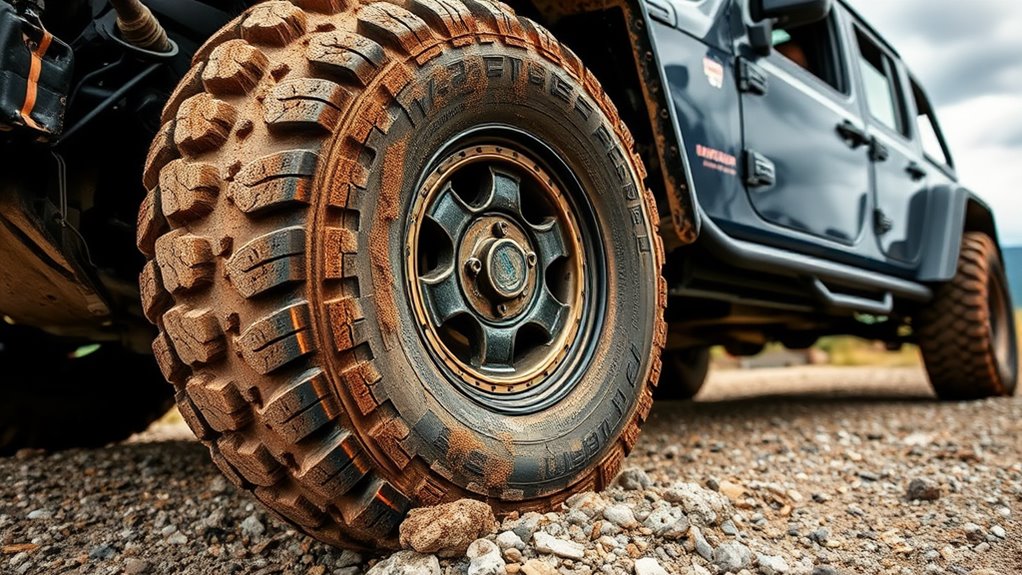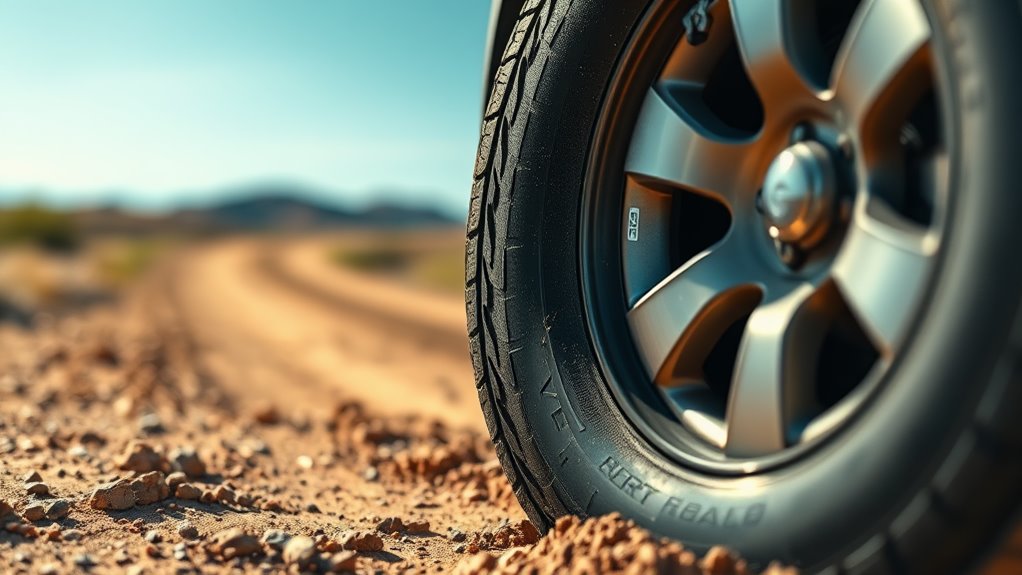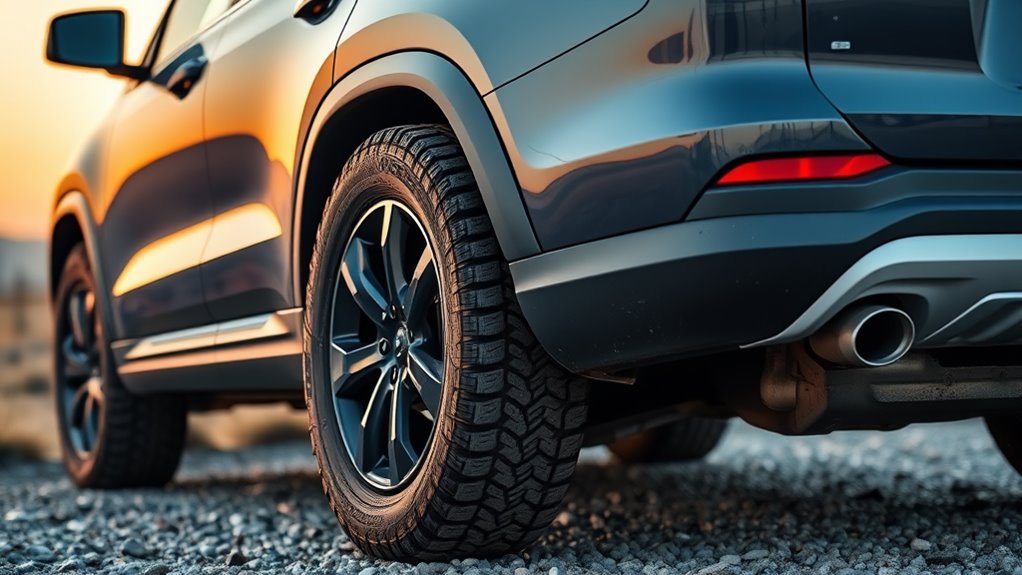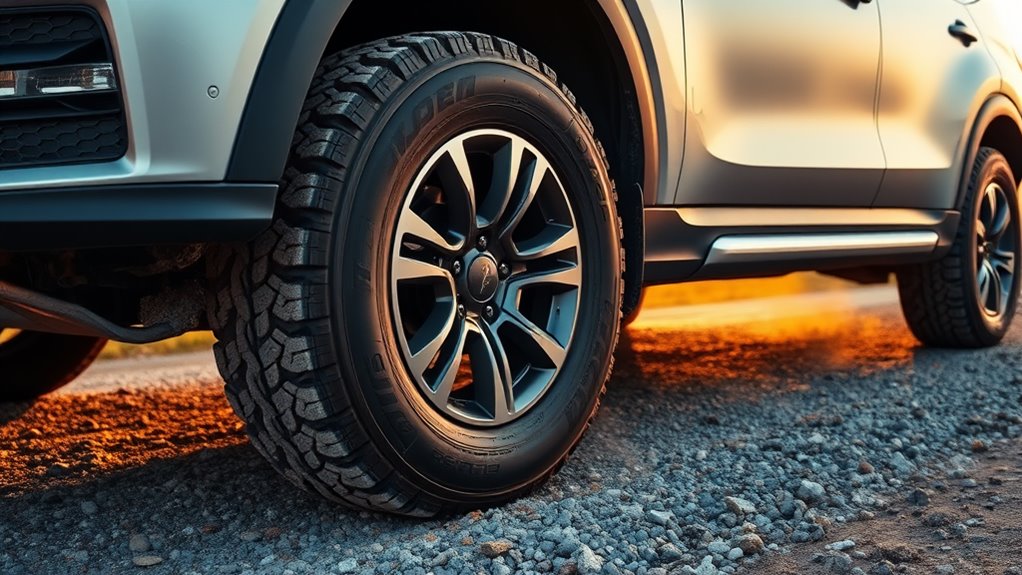Do All Terrain Tires Affect Gas Mileage
This post contains affiliate links. As an Amazon Associate, we earn from qualifying purchases.
All-terrain tires do lower your gas mileage. They cut fuel efficiency by around 3% compared to all-season tires. Why? They have higher rolling resistance and extra weight. Their tough sidewalls add to this weight. Expect a drop of 1-2 MPG. Aggressive tread patterns create more drag—up to 35% on highways. SUVs suffer more, losing 15-25% MPG at slow speeds. Curious about balancing grip and fuel savings? Stick around for tips on that!
Essential Facts in 30 Seconds
- All-terrain tires decrease gas mileage by approximately 3% compared to all-season tires.
- Aggressive tread patterns on all-terrain tires increase drag, reducing fuel efficiency by 1-2 MPG.
- Higher rolling resistance in all-terrain tires leads to lower gas mileage.
- Heavier weight and reinforced sidewalls of all-terrain tires further reduce fuel efficiency.
- Opting for low rolling resistance all-terrain tires can help reduce mileage loss.
Understanding the Impact of All Terrain Tires on Fuel Efficiency
All-terrain tires affect fuel efficiency in many ways. Let’s break it down simply.
These tires cut fuel economy by about 3% compared to all-season tires. Aggressive all-terrain tires drop mileage by 1-2 MPG versus highway tires. At low speeds, you lose 15-25% of MPG. On highways, the loss jumps to 20-35%. Why? Rolling resistance is higher with these tires. Additionally, their reinforced sidewalls add weight, which can further impact fuel consumption.
Tire pressure matters a lot. Low pressure causes up to 10% more fuel loss. Tread designs also impact efficiency. Blocky, aggressive treads create more friction. That hurts mileage. Additionally, compared to mud-terrain tires, all-terrain options often provide better fuel economy.
Check these key points:
- Sedans lose 2-3 MPG, worse than trucks.
- Highway speeds cause a 20-35% fuel drop.
Know these trade-offs to pick the right tires. Balance power and fuel costs for your needs.
Key Design Elements Influencing Mileage Performance

All-terrain tires are great for different roads, but they affect fuel use. Their design changes how much gas your car needs. Bold tread patterns give awesome grip, yet they slow you down. They make the engine push harder, so mileage drops. A simpler tread with even blocks cuts drag a lot. This helps save gas and boosts smooth driving.
Tire weight matters big time for your MPG. Heavy tires with tough sides need more power. This hurts fuel numbers every trip. Smart rubber mixes keep tires strong and flexible. They also stop extra heat, so drag stays low. Additionally, all-terrain tires often have lower rolling resistance compared to mud-terrain options, which can improve fuel efficiency.
Self-cleaning features kick out mud using special channels. Less friction means better efficiency on the road. Reinforced sidewalls add durability for rugged terrains, but may increase weight and fuel consumption reinforced sidewalls. Know these points—tread style, drag, and weight. Pick tires that mix off-road strength with gas savings. Drive smarter and cut fuel costs every day!
Innovations in All Terrain Tire Technology for Better Economy

Let’s dive into how all-terrain tire technology boosts fuel economy. New ideas in tires are making cars use less gas. Think about sensors built right into tires. They check pressure and wear every second. Then, they send info to your car’s system. This helps fix problems before they start.
Smart tech like IoT makes tires adjust to roads. AI helps tires work better for safety and speed. Tough materials and cool designs cut down drag. This means you save more fuel on tough paths. Additionally, silica-reinforced tread compounds are being used to enhance grip while improving fuel efficiency. Larger tire sizes can also impact efficiency, but innovations aim to balance this with better rolling resistance for optimal performance.
Take a peek at this simple table for key ideas:
| New Idea | What It Does | How It Saves Gas |
|---|---|---|
| Built-In Sensors | Track pressure, heat | Stops low tire issues |
| IoT Tech | Changes for road type | Cuts extra drag |
| AI Power | Mixes safety, speed | Lowers rolling fight |
| Cloud Link | Sends data for care | Keeps tires in top shape |
These updates help you drive farther with less gas. You still get great power on rough ground. Isn’t that awesome?
Vehicle-Specific Effects on Gas Consumption

Let’s dive into how all-terrain (A/T) tires affect your gas mileage. Different vehicle features play a big role in fuel use.
Think about tread patterns first. Bold designs with deep lugs add 20-35% more drag on highways. That costs you 1-2 mpg compared to smooth tires.
Vehicle weight matters a lot too. Big trucks or SUVs with heavy A/T tires lose 15-25% mpg at low speeds. On highways, the loss gets even worse.
Your drivetrain type changes things as well. Non-4WD systems often waste more fuel with A/T tires.
Small engines struggle too. Take a Mazda CX-5 as an example. Extra tire strain hurts fuel economy fast.
Check this quick list for clarity:
- Highway trips: Drop 2 mpg.
- Mixed roads: Losses stay even.
- Fast driving: 20-35% fuel penalty.
Stay aware of these impacts. Your vehicle setup decides your gas savings. Additionally, tire width can influence fuel efficiency, as wider tires often create more rolling resistance in various conditions.
Practical Tips for Balancing Mileage and Traction

Balancing mileage and traction with all-terrain (A/T) tires is totally doable. Let’s explore some easy tips to help you out.
First, pick A/T tires with low rolling resistance. These tires cut energy loss and fight a 3% mileage drop. That’s a solid win for fuel savings!
Keep an eye on tire pressure every month. Stick to the maker’s level, like 35 PSI for most SUVs. Low pressure drags down fuel economy fast. Too much pressure? You risk uneven wear and less grip.
Think about tread patterns too. Go for designs with moderate block spacing. They work well on mixed terrains. Efficiency matters, but so does off-road power!
Here’s what to do next. Check tire pressure often—don’t skip it. Rotate tires every 6,000 miles for even wear. Look at tread for damage or uneven spots.
Drive slow on rough roads. Avoid quick starts or hard stops. These small steps save fuel and keep traction strong!
Consider that all-terrain tires differ from all-weather tires in their focus on off-road capability over versatile weather performance.
Frequently Asked Questions
How Do All-Terrain Tires Impact Engine Wear?
Got questions about all-terrain tires and engine wear? Let’s break it down fast. These tires have rough treads that boost rolling resistance. That extra drag pushes your engine harder. Your engine loses efficiency with this added strain. Over months, key parts wear out quicker than usual. Studies show up to 10% faster engine wear. Stick to regular tires for less engine stress. Keep your ride smooth and save repair costs. Ask me anything about tires or engines!
Can All-Terrain Tires Affect Vehicle Resale Value?
Think of your car as a special treasure. The right tires matter a lot. Pick all-terrain tires that buyers love. This choice can raise your car’s resale price. Data shows popular tires attract more buyers. Stick to simple, matching styles for best results. Smart picks make a big difference!
Do All-Terrain Tires Influence Suspension Lifespan?
Got a question about all-terrain tires and suspension lifespan? They sure impact it! These tires have rough treads that stress your suspension a lot. Uneven loads add extra strain on parts over time. Data shows faster tire wear too. This wear pushes your vehicle’s components harder. Keep an eye on that stress! It might shorten your suspension’s life. Stay informed and check tires often!
Are All-Terrain Tires Noisier on Highways?
Think about a peaceful highway drive. Suddenly, your all-terrain tires break the silence. Their bold tread creates more noise on smooth roads. You hear a constant hum during every trip. Studies show these tires raise noise by 5-10 decibels. That’s louder than regular tires! So, expect a noisier ride on highways. Isn’t that a bit annoying? Let’s explore why this happens next.
How Do All-Terrain Tires Affect Braking Distance?
Got questions about all-terrain tires and braking distance? Let’s break it down. These tires often improve stopping power with better grip. You stop faster on different surfaces. Think snow, mud, or gravel—they handle it well. Studies show up to 10% shorter stops in snow. That’s compared to regular tires on the same roads. Pretty cool, right? Stick with these for safer drives.
Conclusion
Think of all terrain tires as tough helpers for rough roads. They often need more gas on hard trails. Why? Their design grips better but fights rolling ease. Studies show a drop of 3-5% in fuel efficiency. That means more trips to the gas station. Yet, new tire tech cuts this loss a bit. Your car type changes the impact too. Big trucks feel less drag than small cars. Driving style matters a lot as well. Speeding burns extra fuel with these tires. Pick tires that match your daily paths. Keep them pumped right for best results. Slow down on bumpy or rocky ground. This saves gas and keeps tires strong. Master your ride with smart choices today.
